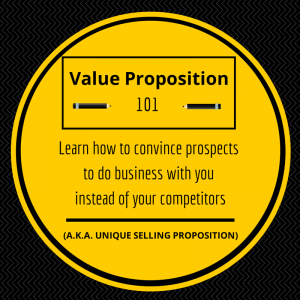3 Key Actions to Boost Your Value Proposition And Grow Your Business

 You may have heard about the importance of your value proposition and its role in communicating the benefit of your company to your ideal customer.
You may have heard about the importance of your value proposition and its role in communicating the benefit of your company to your ideal customer.
But how do you create, position and use your value proposition to really impact your business?
In our experience there are 3 key actions you need to take in order to leverage your value proposition to help grow your business:
1. First - Develop Your Value Proposition
2. Second - Position Your Value Proposition
3. Third - Support and Build the Credibility of Your Value Proposition
Many of the companies we work with struggle to effectively develop, communicate and build the credibility of their value proposition. In fact, most of the content published about value propositions focuses on how to develop them.
Developing your value prop is probably one of the hardest things to do overall, but that’s just the first step. Second, you also need to know how to effectively communicate and best position your value proposition. And third, you need to continually support and build credibility around your value proposition.
Let’s look at each one of these elements a little closer.
1. Developing Your Value Proposition
A value proposition is usually structured as a short 1-2 sentence statement. The goal is to have it resonate with your ideal prospect to the point that they are motivated to engage with you further.
There are 3 key components to creating your value proposition:
- Identify and define your ideal prospect or customer persona.
- Identify the key problems or needs of your ideal prospect or customer persona.
- Identify how your company solves your key problems or needs.
Identify Your Ideal Customer
As you start identifying and defining your ideal customer persona, you should think in terms of niches. For example, as a digital marketing agency, we can work with nearly any size company in any industry located almost anywhere in the world.
While we have large corporate clients and large franchise clients, many of our customers are also small to mid-size companies that have a specific need which is goal- and performance-oriented.
Consequently, we have three (3) targeted customer personas:
- Business Owner Ollie (small business owner)
- Marketing Mary (Vice President - mid-size company)
- Enterprise Erin (Marketing Manager or CMO - large corporations)
Their environment and needs are different; therefore, our service mix for what they are trying to accomplish is tailored to meet their needs.
Identify Your Ideal Customer’s Key Needs and Goals
It is important that you identify the specific problem your ideal customer is trying to solve or the key goal they are trying to achieve.
Many companies who think they know what they need to solve their problems approach us as if we are short-order cooks in a fast food restaurant: “I want a web design with SEO and a little social media and email on the side.”
Or they ask for services that cannot be effectively delivered in today’s world: “I want SEO but hold the social media and content marketing.”
What?!
These businesses typically don’t know what it takes to accomplish the things they are asking for, and that is probably because of how our industry markets and sells silo-based (standalone) services. In today’s world, SEO is content marketing and social media. It’s tough to have success without it.
In a nutshell, the needs of many of our clients boil down to the fact that they need to grow their business by generating more qualified leads that convert to paying customers.
Identify How You Address Your Client’s Key Problems or Needs
It is important to think about how your company solves your customers’ problems or needs and then articulate that in a way that makes sense to them.
Do not address their needs by listing your product or service features. If you do, you are making your visitors figure out how your list of features relates to their problem or need.
Instead, address their problem head on and tie your service or product back in as the fix.
For example, our approach for Owner Ollie is an integrated solution that delivers short term and long term customer growth. Owner Ollie does not have to hire different vendors for what was once standalone services such as custom web design, SEO, social media, email marketing and a marketing automation platform.
Most business owners have heard of phrases like SEO, web design and social media, but they don’t necessarily know how they work. So we present our solution in a way that they understand and care about:
“We generate relevant visitors to your website, educate them and convert these visitors into qualified leads. We can then nurture your qualified leads until they are ready to talk to a sales person. We’ve done the heavy lifting for the sales team so they can do what they do best – close deals on pre-qualified leads.”
A business owner understands this approach very well because it matches their marketing and sales cycle.
2. Positioning Your Value Proposition
Now that you’ve developed your value proposition, you should think about where you want to position it on your website.
Let me start with a simple truth - You are your website.
- If your website looks cheap, your visitors will think your products and services are cheap.
- If your website is difficult to navigate, you give the impression that you are difficult to work with.
- If you lack compelling content or detailed information about how you solve your visitors’ problems, they think you are not a leader or expert in your industry.
Although we have validated these impressions from our own clients, these simple truths are based upon Harvard research results.
In addition, you have 7 seconds from the time your visitor lands on your website for your value proposition to answer the questions, “Why should I choose you?” or “Why should I continue to engage further on your website?”
Therefore, your value proposition needs to be placed above the screen line on your website. It is a 1-2 sentence statement so it does not take up a lot of space.
When someone comes to your website, you need your value prop to quickly identify your key value to your potential customer. It is very important that everything else throughout your website supports your value proposition.
You may have to tweak it somewhat based upon where you place it on your Home page, but there are several different places where it can work:
- Banner with text
- H1 or title of page
- Caption under banner or hero shot
It is very important that you state your value proposition on the home page and then continue to reinforce it throughout the rest of the site. Ignoring the value prop after the home page is detrimental. Therefore, your value proposition has an impact on your overall website design, page layout, content, images, videos and usability.
If you offer multiple products, then you need to determine how you are going to improve your value proposition to support each product or service category on their respective pages. The value proposition for your product needs to support and align itself with your company value proposition.
3. If your company offers a singular product, then it is possible that your company value proposition and your product value proposition can be the same. Support and Build the Credibility of Your Value Proposition
Because your value proposition is 1-2 sentences long, it alone is typically not enough to make it credible. Even a compelling value proposition placed in the most ideal position on your website needs supporting credibility for web users who are a cynical bunch and less responsive to marketing hype.
Everyone says their products are the best – but no one believes you. Thus, everything on your website has to support your value proposition. This includes your design, text, images, blog articles, videos and user experience. It all has to support and validate your value proposition.
One of the best places you can continue to support and promote your value proposition is through blog articles. Today, more than ever, you need to think and act like a publisher in order to present yourself and your company as a leader in your industry.
According to a HubSpot research report, the most important factor on a website for consumers (79%) is finding the information they are looking for. The more information you provide on your website, the greater opportunity you have to answer the needs of your visitors.
Blog articles are a great way to draw new visitors to your website by getting more and more content out on the internet with information that not only answers their questions but also supports your value proposition.
In fact, referral website traffic to blog articles that have been socially shared throughout the internet drive 30%-60% of our customers’ total website traffic. These same blog articles have a significant impact on their SEO rankings.
Blog articles can build enormous credibility for your company and can demonstrate the strength of your value proposition. Other forms of content that can support your value proposition include:
- Press releases
- Testimonials
- Reviews
- Content offers such as guides, white papers, case studies, and ebooks
- Awards, recognition, certifications, memberships, associations, and Better Business Reliability program
Build and Support Your Value Proposition For Continued Growth
Creating, positioning and supporting your value proposition through the design and content on your website as well as your content marketing efforts gives you the best chance to quickly connect with your ideal prospect in a way that is relevant to their needs or problems. Separate yourself and your company from your competition by continuing to build upon your value and how it will help your prospective clients.
Download the case study below to learn how a value proposition and its related elements helped increase website conversions by 210% for a real estate developer.







